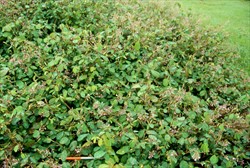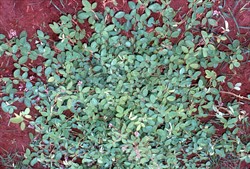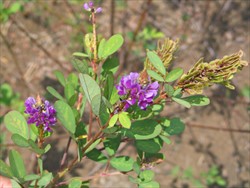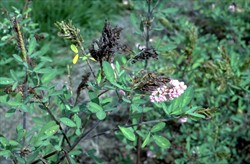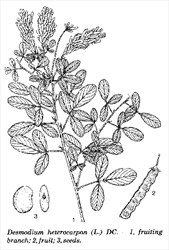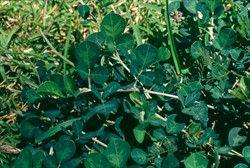Grona heterocarpa subsp. heterocarpa
Tropical Forages
Grona heterocarpa (L.) H. Ohashi & K. Ohashi subsp. heterocarpa var. heterocarpa
Basionym: Hedysarum heterocarpon L.; Desmodium heterocarpon (L.) DC. subsp. heterocarpon; Desmodium polycarpon (Poir.) DC.; Desmodium polycarpon var. polycarpon (Poir.) DC.; Hedysarum polycarpon Poir.; Meibomia heterocarpos (L.) Kuntze
Family: Fabaceae (alt. Leguminosae) subfamily: Faboideae tribe: Desmodieae.
A perennial (3‒5 years) sub-shrub, sometimes a shrub or herb, ascending or often creeping with a woody rootstock. Stems and branches up to 1 m long, diffuse and ascending or erect, although prostrate under heavy grazing. Adventitious rooting sometimes occurs from stems lying on the soil surface. Stems range from nearly glabrous to densely covered with white or yellowish hairs. Leaves are generally trifoliolate, though unifoliolate leaves are common on seedlings and not unusual toward the base of mature stems. Leaflets mostly papery, smooth on the upper surface and hairy underneath, often with a light green to almost yellow watermark on the upper surface. Terminal leaflet normally broadly elliptic, ovate or often obovate, with tips generally retuse. Inflorescence terminal and axillary racemes, densely flowered; flower colour ranging from pink to violet or white. Pods erect or ascending, narrowly oblong, compressed and generally 4‒8-jointed, turning from green to dark brown on maturity. Articles quadrangular to semi-elliptic, straight along the upper suture, somewhat rounded below, separating and then dehiscing. Seeds broadly elliptic, cream to orange in colour, 2 × 1.5 mm. 700,000‒800,000 seeds per kg.
subsp. heterocarpa: Erect or ascending or prostrate herbs or subshrubs. Terminal leaflets usually obovate elliptic or oblong sparsely to subdensely hairy above. Inflorescence elongated. Flowers 3‒4 mm long with pedicels 4‒7 mm long. Pods sparcely to densely pubescent whit hooked and straight hairs (0.1‒1.5 mm long).
subsp. ovaIifoIia: Prostrate stoloniferous herbs or subshrubs. Terminal leaflets ovate or elliptic to broadly ovate acute or obtuse glabrous or nearly glabrous above. Inflorescence short usually less than 5 cm long very densely flowered. Flowers more than 4 mm long with pedicels 2‒3 mm long. Pods with densely long yellowish or whitish hooked-hairs (0.5‒1.5 mm long).
Description based on Ohashi (1991).
Asia: baay dâm’nnaëp (Cambodia); 假地豆(原变种) jia di dou (yuan bian zhong) (China); buntut meyong sisir, kaci, akar entimor (Indonesia); shiba-hagi (Japan); rumput kerbau derapah, kacang kayu betina (Malaysia); mangkit-parang, mani-mani, huyo-huyop (Philippines); tràng quả dị quả (Vietnam)
English: carpon desmodium, Asian tick trefoil
Indian subcontinent: ಕಾಡು ಮೂವಿಲೆ kaadu moovile (Kannada); നിലത്തുവര nilaththuvara (Malayalam); जांभळी दशमी jambhali dashami (Marathi); शालपर्णी salaparni (Sanskrit); చెప్పుతట్ట chepputatta (Telugu); ಕಾಟ್ಟುಮೂಜಿರೆ kattumoojire (Tulu)
Pacific: piri piri, pua marino (Mangareva, French Polynesia); okula beluu (Palau); kaamalimal, kamelimel, kehmelmel en nansapw (Pohnpei); ea ea, piripiri ‘aratita, piripiro, tia pipi, toharea (Tahiti); ngingie'uta (Tonga)
Africa: Tanzania
Asia: Bangladesh, Bhutan, Cambodia, China (s.), India, Indonesia, Japan, Laos, Malaysia, Myanmar, Nepal, Philippines, Sri Lanka, Taiwan, Thailand, Vietnam
Australasia/Papuasia: Australia, Papua New Guinea
Pacific: Fiji, Micronesia, New Caledonia
Naturalized:
Naturalized elsewhere.
Forage
For grazing in long-term grass-legume pastures.
Other
The whole plant is used medicinally for reducing fever and for treating contusions and strains.
Soil requirements
Range of well-drained soils of light texture, including the better-drained mineral soils of southern Florida. Needs moderate soil P levels. Can tolerate pH 4.3‒5 and high Al saturation. Can suffer from trace element deficiency on neutral or alkaline soils.
Moisture
Average annual rainfall of 1,250‒1,500 mm in Florida but up to 2,500 mm elsewhere. Mature plants have some drought tolerance but seedlings are very susceptible. The great drought of 2000/01 was responsible for the loss of much carpon desmodium in central and southern Florida. Carpon desmodium can survive up to a week of intermittent shallow flooding, but not extended periods.
Temperature
Carpon grows well in cooler conditions, as in Florida spring, but most growth (65%) is in summer. Tolerates repeated light frosts and can grow to 2,500 m asl in the tropics.
Light
No information available.
Reproductive development
No information available.
Defoliation
Tolerant of heavy grazing when it develops a prostrate growth habit with a very low-lying crown and protected meristems. When grown with aggressive grasses such as Paspalum notatum, heavy rotational (3‒6 weeks) grazing is recommended to prevent grass dominance.
Fire
No information available.
Guidelines for establishment and management of sown forages.
Establishment
In southern Florida, USA seed can be planted any time from after the last frost until August, but little or no seed will set during the first year unless germination occurs before July. On clean seed beds, seeding rate is 3‒5 kg/ha, but 5‒10 kg/ha in established grass areas; nodulates with native cowpea rhizobium. Hard-seed levels of 50‒65%. Seedling growth is slow, but once established, carpon can persist for more than 10 years without special grazing management.
Fertilizer
In southern Florida, recommendations are about 2.5 t lime/ha, 45‒50 kg P and K/ha on virgin flatwood soils, with annual maintenance dressings of about 300 kg/ha of 0-10-20 (N:P:K).
Compatibility (with other species)
Once established carpon competes well with aggressive grasses provided they are grazed moderately heavily and not fertilised with nitrogen. In a trial with continuous grazing of a mixture of three tropical legumes with bahia grass ( Paspalum notatum), the short-lived legumes joint vetch ( Aeschynomene americana) and phasey bean ( Macroptilium lathyroides) contributed to diets during the first summer, whereas the contribution of carpon was greater in the second summer.
Companion species
Grasses: Axonopus fissifolius, Digitaria eriantha, Hemarthria altissima, Paspalum notatum in Florida.
Legumes: Combines well with white clover (Trifolium repens) and short-lived species such as Aeschynomene americana and Macroptilium lathyroides.
Pests and diseases
Damage caused by several foliar diseases has been reported: leaf-spots (Cercospora sp., Pestalotiopsis versicolor) and anthracnose (Colletotrichum gloeosporioides) in southern USA and South America, also powdery mildew (Oidium sp.) and wilt (Sclerotium rolfsii). In Florida, carpon is susceptible to at least two species of root knot nematodes (Meloidogyne incognita and M. arenaria) and should not be planted in infested areas; cv. Florida is particularly susceptible. Little leaf mycoplasma has been recorded as moderate to severe in Central and South America. Web-worms and other insects can attack the foliage and seed pods in long ungrazed stands during flowering and seed maturation, but are best controlled by grazing.
Ability to spread
Carpon can be spread through the dung of stock grazing the seed heads. Resting a grass-legume pasture for the legume to seed and then introducing stock is recommended to maintain legume soil seed reserves for regeneration. A bahia grass ( Paspalum notatum) pasture with a good stand of carpon desmodium had soil seed reserves of more than 300 seeds/m², equivalent to about 3 kg/ha.
Weed potential
Although generally considered a fairly benign species, it is classified as invasive in a number of Pacific islands.
Nutritive value
Less nutritious than legumes such as Aeschynomene and Stylosanthes. The foliage contains 9‒20% CP, depending on growth stage, while grass/legume mixtures average 9‒10% CP. 'Florida' carpon desmodium leaf CP averaged 17.6% (compared with 6.8% for bahia grass). Some 130 kg N/ha/yr has been measured in harvested forage, equivalent to 190‒260 kg N/ha applied to pure pangola ( Digitaria eriantha) and bahia grass ( Paspalum notatum) pastures. IVOMD of mixtures with grasses ranged from 45 to 60%, depending on the grass and season of the year. IVOMD of 'Florida' carpon desmodium leaves was low in summer (47.0 vs 51.2% for bahia grass during the same period). Tannin percentages from two cuts were 2.3 and 3.1%.
Palatability/acceptability
In 5 years of commercial grazing in Florida, acceptability of 'Florida' carpon desmodium by cattle was reported to be satisfactory in spite of the tannin.
Toxicity
Probably none.
Dry matter
In Florida, carpon desmodium contributed an estimated 40% to the total yield of 13.6 t DM/yr of a mixture with Coastcross 1 Bermuda grass (Cynodon dactylon).
Animal production
No data reported.
2n = 22. Very polymorphic due to a high degree of cross-pollination; selfing is favoured by flowers being tripped.
In Florida, flowering begins in early September and seed matures by November. Mature pods do not shatter readily; often a grass/legume mixture is mown when 85‒90 percent of the legume pods are mature. The herbage is allowed to dry for at least one day, and preferably 2‒3 days, before pick-up threshing. Pick-up threshing is preferable to direct heading because the vegetative material still has a high moisture content at this stage, and is likely to gum the threshing bars of the drum if direct headed. After seed harvest the stand is allowed to revert to a grazed pasture. Seed yields of 100 kg/ha have been reported.
No information available.
- Resilient, easy to manage.
- Combines with aggressive grasses.
- Cool season growth.
- Susceptible to root-knot nematodes.
- Medium to low quality.
Aiken, G.E., Pitman, W.D., Chambliss, C.G. and Portier, K.M. (1991) Responses of yearling steers to different stocking rates on a subtropical grass-legume pasture. Journal of Animal Science 69:3348–3356. doi.org/10.2527/1991.6983348x
Hacker, J.B. and Kretschmer, A.E. Jr. (1992). Desmodium heterocarpon (L.) DC. In: Mannetje, L't. and Jones, R.M. (eds) Plant Resources of South-East Asia No. 4. Forages. Pudoc Scientific Publishers, Wageningen, the Netherlands. p. 106–108. edepot.wur.nl/327785
Kretschmer, A.E. Jr., Brolmann, J.B, Snyder, G.H. and Coleman, S.W. (1982) Registration of 'Florida' carpon desmodium (Reg. No. 24). Crop Science 22:158–159. doi.org/10.2135/cropsci1982.0011183X002200010041x
Kretschmer, A.E. Jr., Brolmann, J.B., Snyder, G.H. and Coleman, S.W. (1979) 'Florida' carpon Desmodium: a perennial tropical forage legume for use in south Florida. Agricultural Experiment Station Circular S-260. University of Florida, Gainesville, USA.
Lenné, J.M. and Stanton, J.M. (1990) Diseases of Desmodium species. Tropical Grasslands 24:1–14. bit.ly/2w0YLe8
Ohashi, H. (1991) Taxonomic studies in Desmodium heterocarpon (L.) DC. (Leguminosae). Journal of Japanese Botany 66:14–25. jjbotany.com/pdf/JJB_066_14_25.pdf
Ohashi, H. and Ohashi, K. (2018) Grona, a Genus Separated from Desmodium (Leguminosae Tribe Desmodieae). Journal of Japanese Botany 93(2):104–120. jjbotany.com/pdf/JJB93-2_104-120_abstract.pdf
‘Florida’ (PI 217910, IRFL 588, CPI 49729, CPI 83596, CPI 86277, CPI 100451) Released in Florida, USA in 1979. The original collection was obtained from the Forest Research Insitute, Dehra Dun, Uttar Pradesh, India.
None reported.
